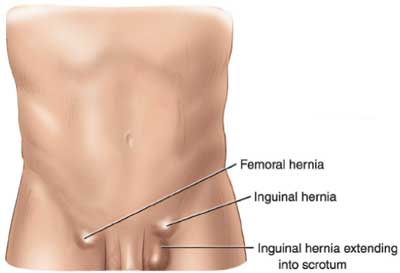LAPAROSCOPIC AND ROBOTIC HERNIA REPAIR WITH MESH
In case of an inguinal hernia (swelling in the groin area), Dr.Hirides may suggest surgical repair, in order to avoid serious complications (strangulation, ie when an intestinal loop is trapped inside the hernia sac, its blood supply is blocked and eventually becomes necrotic). Also, because surgery is the only way to treat a hernia (no medication or other conservative measure helps).
Occasional use of an abdominal compression waist belt, not only does not fix the problem, but it may lead to injury of the intestinal loops, increasing probability of adhesion formation (tough, scar like tissue, which will make surgical repair more difficult and technically demanding)
Surgical repair of an inguinal hernia, is nowadays performed laparoscopically, ie through 3 small incisions in the abdominal wall (of a diameter 0.5-1cm), whilst classic (open) repair is still performed by a high number of surgeons, who either have not had the appropriate training in advanced laparoscopy, or in case a laparoscopic procedure is not feasible. Robotic repair of an inguinal hernia is an evolution of the laparoscopic techniques, and it most probably offers potential advantages in selected patients. Those advantages include: a three-dimensional view, high-definition stereoscopic image of the operative field, and a higher degree of motion freedom for the robotic instruments.
Athletes and specifically soccer players, consist a special category of patients who present with injuries in the inguinal area, due to tough training, ending up with chronic pain (athlete’s hernia-chronic inguinal pain-abdominal adductor syndrome). An athlete’s hernia presents with significant improvement following placement of a mesh in the area, whilst in many athlete’s cases true hernias can be found with defect in the abdominal muscles.

During laparoscopic repair of an inguinal (or sports) hernia, your surgeon Dr,Hirides, will gain access to the area below the abdominal muscles and outside the peritoneal cavity (extraperitoneal approach) and will insufflate air (carbon dioxide) in the abdominal cavity to expand it and create the necessary workspace. Then, the surgeon will locate the hernia and reduce it (ie he will mobilize the part of intestine lying outside the hernia defect and reposition it back, inside the abdominal cavity).
Furthermore, he will identify and protect the important content of the spermatic cord (the tube which includes the testicular vessels, cremaster muscle and vas deferens in men; and in women the round link of the uterus). Following the additional identification and preservation of crucial verssels and nerves in the inguinal region, and after reduction of the hernia, surgeon will go ahead with placement of the mesh. Throughout the whole procedure, surgeon S.C Hirides uses specific laparoscopic energy instruments that help him divide and cauterize small vessels, so that the whole operation takes place without blood loss. The mesh is made from special material (for example PTFE), that create an intense fibrous reaction, resulting in healing and strengthening of the defect in the following couple of weeks. Mesh is folded in an appropriate way, to make sure that it will fit through the 1cm incision of the optical trocar. In order to fixate the mesh in place, he usually uses clips (absorbable ones) and/or biological (fibrin) glue. After making sure that placement of the mesh and bleeding control have been completed, all instruments are removed and carbon dioxide is expelled from the operative field. Wounds are stitched intradermally, and skin is reapproximated in its original position.
In the evening following the procedure, most patients will be able to drink and have a light meal. Usually, they are discharged during the next day, with specific instructions: to avoid exercise, lifting weights for a 30-day period, and to be cautious with their diet for the first couple of days following the procedure to avoid dyspepsia and bloating. The excellent results brought forward by our team, show that patients who undergo a laparoscopic procedure for inguinal Hernia repair, are able to return to work, even the following day after the procedure.
Translation : Katerina Vassilopoulos (London, UK)
